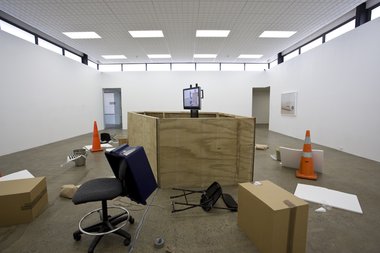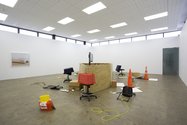John Hurrell – 5 November, 2010
The fourth artist, Koki Tanaka, seems to work in the spirit of the Gutai group, precursors of Fluxus in the fifties, who believed that the spirit of a substance is released when it is vandalised - that destruction as a positive force can achieve that. His ARTSPACE work is rich in cheeky humour, for part of his procedure as a visitor to Auckland has been to take John Reynolds, Billy Apple and Gordon Walters posters and shred them by violently jamming them between two buckets.
Auckland
Dan Arps, Layla Rudneva-Mackay, Kim Beom, Koki Tanaka
A rock that was taught it was a bird
Curated by Emma Bugden
16 October - 20 November 2010
This exhibition - according to its flier - explores ‘the complex relationship between objects and people,’ and you might well wonder what could be more open-ended than that? What artwork doesn’t involve people and objects?
However Emma Bugden’s selection, when you see the show, makes a lot of sense and is not simple-minded. It looks at the concept of reism as exemplified in the activities of the Slovenian conceptualists OHO, who thought that objects have as equal a place in the world as humans, that they are not silent and that we can ‘entice the unheard voice from a thing’.
The title, The rock that was taught it is a bird, comes from the work of Kim Beom who is shown in a video giving a lecture to a hefty geological speciman on why it flies and builds nests in trees. Using books and various pedagogical aids like cards and posters, he tells it of its evolutionary development, ecological position, and bodily and behavioural characteristics, eventually ‘teaching it’ to balance on a branch. (‘You are not still thinking you are a rock are you?’)
Though Beom is ostensibly similar to Peter Cook who in a 1965 skit with Dudley Moore spoke in detail of teaching ravens to fly underwater, Beom is not chasing laughs, but closer to the position of Michael Craig Martin and his famous 1973 Oak Tree - consisting of a glass of water on a shelf (and an explanatory wall label), or Robert Rauschenberg’s famous 1961 telegram, ‘This is a portrait of Iris Clert if I say so.’ All three emphasize artist’s intention.
Next to the entrance to oher galleries, and less frenetic in mood is an elegant photograph by Layla Rudneva-Mackay of a bloke lying facedown on a bed covered over (apart from protruding socked feet) with a thick mattress and two fluffy duvets. His body is a horizontal element parallel with the furniture and accessories it is jammed between - like clay strata in a cliff face.
Dan Arps‘ contribution to this show is an installation that alludes to Fantazy Land, in Alexandria in Egypt, allegedly the world’s worst theme park. It is not so much a satire as a starting point for the manipulation of materials, a narrative (anti-aesthetic) action with symbols, a process that incorporates with raw mark making, some of the tools, worn clothing and packaging from various used products into itself. The theme park with its incorporation of quoted architectural prototypes, is juxtaposed with a rack of hanging circuit-boards and gloves - perhaps a comment on digital mediation as a numbing deferral of direct experience.
The fourth artist, Koki Tanaka, seems to work in the spirit of the Gutai group, Japanese precursors of Fluxus in the fifties, who believed that the spirit of a substance is released when it is vandalised - that destruction as a positive force can reveal an object’s ‘inner life.’ His work consists of carefully preplanned actions where brutally damaged or rapidly altered items or materials are abandoned where they fall. His ARTSPACE work is rich in cheeky humour, for part of his procedure as a visitor to Auckland has been to take John Reynolds, Billy Apple and Gordon Walters posters and shred them by violently jamming the printed paper sheets between two buckets.(These actions might be a slap in the face to New Zealand art in general or a knee in the nuts to tasteful design, an embracing of dramatic or tasteless gesture.)
What is particularly interesting about these four works - even more than their relationship with objects - is their range of attitudes towards visual pleasure. The Rudneva-Mackay work is positively seductive with its pale whites and creams, and thin dotted dark-red line following the edge of a folded duvet. The work has a Boyd Webbish ambience in its humour, but is even more tasteful visually.
The opposite extreme is Koki Tanaka, who is all about bodily movement and art residue, a narrative and its consequences - while circling around a wonky coffin shaped form. There is no intervention to make the installation or documentation of process more optically appetising. The work, with its incessant knocking over, flattening and breaking of polystyrene and cardboard objects, seems genuinely indifferent to any type of prissiness. It has a measured pace to its smashings up. It is never too rushed.
Arps’ project is not as extreme as Tanaka’s, for there is a cultivated sensibility (albeit raw) that is almost inseparable from the inventiveness in technical method and slyness of humour. He has a house style which even when he is being formal, is never too formal. He always avoids rigorous precision and any hint of anal fastidiousness.
Beom on the other hand is preoccupied with the imagination and quality of unorthodox argument - as apparent with his own presentation to the audience. With his sweater and baseball cap, he looks like your average amateur ornithologist, but with his meticulous camera angles, sequences of scientific discussion, and footage of the rock in a tree, his art is more than just documenting a scripted verbal performance. The details are well considered. His bizarre spoken thoughts (as they seem to us) are his actions, and are just as palpable as those of Tanaka when he is jumping on a cardboard box to squash it.
This is cleverly selected, nuggetty and stimulating show really grows on you. Well worth a lengthy visit.
John Hurrell










 Two Rooms presents a program of residencies and projects
Two Rooms presents a program of residencies and projects Advertising in this column
Advertising in this column



This Discussion has 0 comments.
Comment
Participate
Register to Participate.
Sign in
Sign in to an existing account.